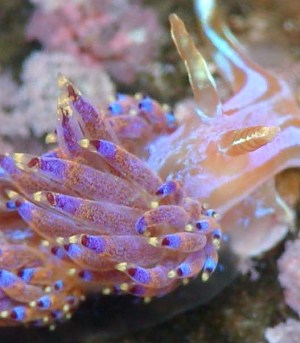
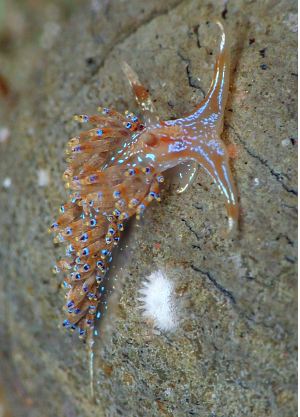
Setoeolis inconspicua
(Baba, 1938)
Order: NUDIBRANCHIA
Suborder: AEOLIDINA
Family: Glaucidae
PHOTO
Echizen-coast Wakasa Bay, Japan, 4 m, 10 July 2002. Upper: approx 17mm long., Lower: approx 12mm long. Photos: Jun Imamoto.
Oral tentacles slender, rhinophores irregularly wrinkled or weakly annulate. The cerata are arranged in large horseshoe-shaped clusters. Baba describes head and body as 'pale orange-yellow with a white line on oral tentacles' but photos here show that there can be a series of opaque white bands, or rows of patches or spots on the head and tentacles. The ceratal wall can be translucent clear with little pigmentation or can have quite a dense covering of opaque bluish white obscuring the brown digestive gland duct. At the top of the cerata there is a subapical yellow band. Below this is a transparent region through which the dark brown or purple tip of the digestive gland duct can be seen and then there is a bright blue or bluish purple band. Baba (1965) examined further specimens of this species and noted its anatomical similarity to Godiva quadricolor but noted it lacked the apical hook on the penis characteristic of the genus Godiva. On the basis of this difference he erected a new genus Setoeolis from this species.
From the photos on the Forum this is quite variable in colour. One consistent feature appears to be the ceratal colouration with a subapical yellow band, below which is a transparent region through which the dark brown or reddish brown tip of the digestive gland duct can be seen, then below this a blue or bluish-purple band. Below this band the cerata wall can be transparent, or have scattered white patches or be almost completely covered in white dusting.
References:
• Baba, K. (1938) Opisthobranchia of Kii, Middle Japan. Journal of the Department of Agriculture. Kyusyu Imperial University, 6(1): 1-19.
• Baba, K. & Hamatani, I. (1965) The anatomy of Sakuraeolis enosimensis (Baba, 1930), n. g. (=Hervia ceylonica (?) Eliot, 1913) (Nudibranchia - Eolidoidea). Publications of the Seto Marine Biological Laboratory, 13(2): 103-113, Pls.VIII-X
Rudman, W.B., 2002 (July 17) Setoeolis inconspicua (Baba, 1938). [In] Sea Slug Forum. Australian Museum, Sydney. Available from http://www.seaslugforum.net/find/setoinco
Related messages
Setoeolis inconspicua from Japan.
July 24, 2002
From: Jun Imamoto
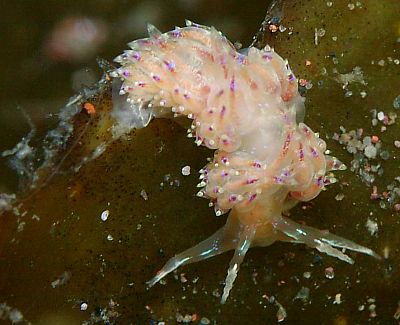
Dear Bill.
Following your comments on my earlier message here are some photos of another colour form of Setoeolis inconspicua
Osezaki, Izu Peninsula, Suruga bay, Japan
Depth: 10m, Water temperature: 19C degrees.
Size: about 20mm. 11 May 2002
Best Regards,
Jun Imamoto
imamoto@wips.co.jp
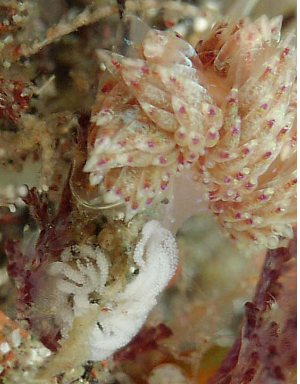
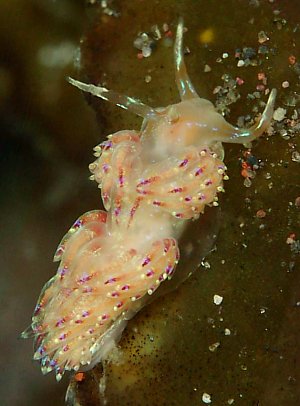
Dear Jun,
This animal lacks most of the opaque orange pigmentation on the body wall but otherwise would seem to be the same. It certainly shows the characteristic colour bands on the cerata.
Best wishes,
Bill Rudman
Setoeolis inconspicua? from Japan (1)
July 23, 2002
From: Jun Imamoto

Dear Bill.
I have problems identifying this sea slug. It is being called Setoeolis inconspicua (Baba, 1938)in Japan, but I can't find any information about that species. However, it seems to look like Godiva quadricolor (Barnard, 1927) as well.
Because there is quite a lot of variation I have sent photos of three animals in separate messages. I would be very happy if I could hear your comment. [see also message 2, message 3]
Data:
Echizen-coast Wakasa Bay, Japan, approx 17mm long, depth: 4m, 10 July 2002.
Best Regards,
Jun Imamoto
imamoto@wips.co.jp
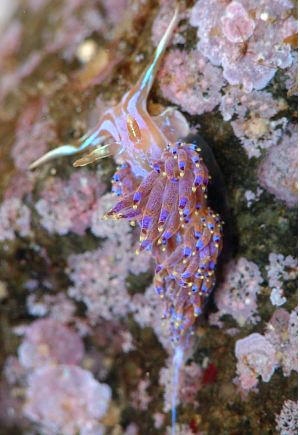
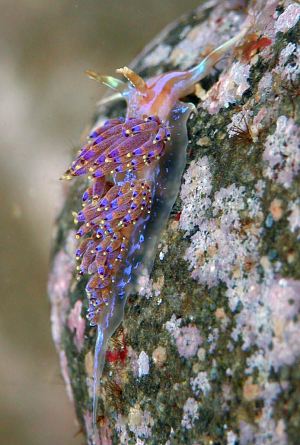
Dear Jun,
Thanks for these detailed photos. Setoeolis inconspicua is not well illustrated in the literature, and the only detailed description is Baba's original description (1938) which did not include a colour illustration. Your photos are a valuable contribution to our knowledge of the species. Although it appears quite variable in colour, the colour bands on the cerata seem to be fairly constant, with a subapical yellow band, below which is a transparent region through which the dark brown or reddish brown tip of the digestive gland duct can be seen, then below this a blue or bluish-purple band. Below this band the cerata wall can be transparent, or have scattered white patches or be almost completely covered in white dusting.
Is it the same as the South African Godiva quadricolor? It certainly has similarities in colour but there are some differences in ceratal colour. In Gosliner, T. (1987) Nudibranchs of Southern Africa the cerata have two or three yellow bands separated by bluish bands. Between these bands the reddish brown digestive gland duct can be seen through the transparent ceratal wall. In Valda Fraser's photos there is only one yellow band on the cerata but it is lower than in S. inconspicua and has a blue band above it, rather than below it. However there are anatomical differences, the simplest of these being the presence of a penial hook in G. quadricolor which is absent in S. inconspicua. Baba used this character to erect the genus Setoeolis for S. inconspicua. The last comprehensive review of the Glaucidae (Miller, 1974) accepted both Godiva and Setoeolis as good genera so until more studies are undertaken I suggest we continue to accept this distinction.
• Miller, M.C. (1974) Aeolid nudibranchs (Gastropoda: Opisthobranchia) of the family Glaucidae from New Zealand waters. Zoological Journal of the Linnean Society, 54(1): 31-61.
Best wishes,
Bill Rudman
Setoeolis inconspicua? from Japan (2)
July 23, 2002
From: Jun Imamoto
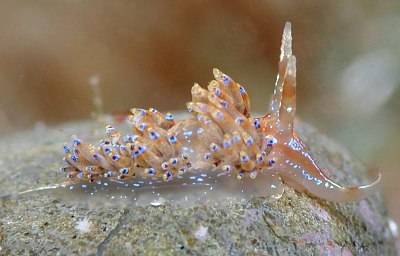
Dear Bill,
To accompany my earlier message here is another colour form of Setoeolis inconspicua.
Data:
Echizen-coast Wakasa Bay, Japan, approx 12mm long, depth: 4m, 10 July 2002.
Best wishes,
Jun Imamoto
imamoto@wips.co.jp
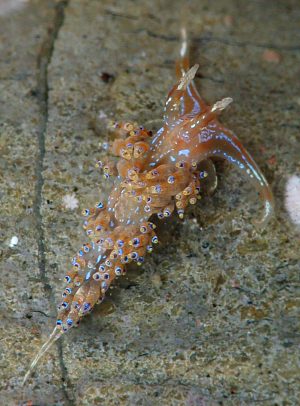

Thanks Jun,
Bill Rudman
Setoeolis inconspicua? from Japan (3)
July 23, 2002
From: Jun Imamoto
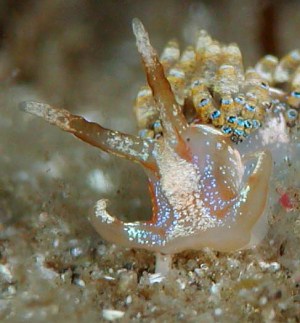
Dear Bill,
To accompany my earlier message here is another colour form of Setoeolis inconspicua.
Data:
Echizen-coast Wakasa Bay, Japan, approx 12mm long, depth: 4m, 10 July 2002.
Best wishes,
Jun Imamoto
imamoto@wips.co.jp
![]()
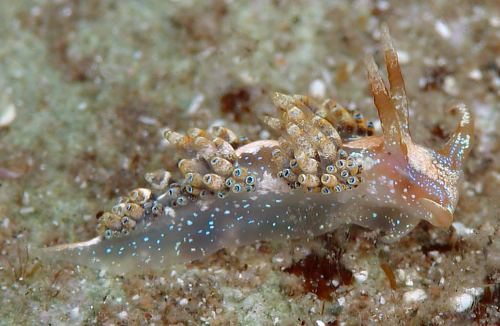
Thanks Jun,
Bill Rudman
